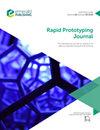Non-destructive evaluation of melt-extruded part quality using in situ data
IF 3.6
4区 工程技术
Q1 ENGINEERING, MECHANICAL
引用次数: 0
Abstract
Purpose This study aims to collect real-time, in situ data from polymer melt extrusion (ME) 3D printing and use only the collected data to non-destructively identify printed parts that contain defects. Design/methodology/approach A set of sensors was created to collect real-time, in situ data from polymer ME 3D printing. A variance analysis was completed to identify an “acceptable” range for filament diameter on a popular desktop 3D printer. These data were used as the basis of a quality evaluation process to non-destructively identify spatial regions of printed parts in multi-part builds that contain defects. Findings Anomalous parts were correctly identified non-destructively using only in situ collected data. Research limitations/implications This methodology was developed by varying the filament diameter, one of the most common reasons for print failure in ME. Numerous other printing parameters are known to create faults in melt extruded parts, and this methodology can be extended to analyze other parameters. Originality/value To the best of the authors’ knowledge, this is the first report of a non-destructive evaluation of 3D-printed part quality using only in situ data in ME. The value is in improving part quality and reliability in ME, thereby reducing 3D printing part errors, plastic waste and the associated cost of time and material.用原位数据对熔融挤压件质量进行无损评价
本研究旨在从聚合物熔体挤出(ME) 3D打印中收集实时、原位数据,并仅使用收集到的数据来非破坏性地识别含有缺陷的打印部件。设计/方法/方法创建了一套传感器,用于从聚合物ME 3D打印中实时收集原位数据。方差分析完成,以确定一个“可接受的”范围内的长丝直径在一个流行的桌面3D打印机。这些数据被用作质量评估过程的基础,以非破坏性地识别包含缺陷的多部件构建中的打印部件的空间区域。发现仅使用原位收集的数据即可正确识别异常部分。该方法是通过改变细丝直径来开发的,而细丝直径是ME打印失败的最常见原因之一。已知许多其他打印参数会在熔融挤出部件中产生故障,并且该方法可以扩展到分析其他参数。原创性/价值据作者所知,这是首个仅使用ME原位数据对3d打印部件质量进行无损评估的报告。其价值在于提高ME的零件质量和可靠性,从而减少3D打印零件错误、塑料浪费以及相关的时间和材料成本。
本文章由计算机程序翻译,如有差异,请以英文原文为准。
求助全文
约1分钟内获得全文
求助全文
来源期刊

Rapid Prototyping Journal
工程技术-材料科学:综合
CiteScore
8.30
自引率
10.30%
发文量
137
审稿时长
4.6 months
期刊介绍:
Rapid Prototyping Journal concentrates on development in a manufacturing environment but covers applications in other areas, such as medicine and construction. All papers published in this field are scattered over a wide range of international publications, none of which actually specializes in this particular discipline, this journal is a vital resource for anyone involved in additive manufacturing. It draws together important refereed papers on all aspects of AM from distinguished sources all over the world, to give a truly international perspective on this dynamic and exciting area.
-Benchmarking – certification and qualification in AM-
Mass customisation in AM-
Design for AM-
Materials aspects-
Reviews of processes/applications-
CAD and other software aspects-
Enhancement of existing processes-
Integration with design process-
Management implications-
New AM processes-
Novel applications of AM parts-
AM for tooling-
Medical applications-
Reverse engineering in relation to AM-
Additive & Subtractive hybrid manufacturing-
Industrialisation
 求助内容:
求助内容: 应助结果提醒方式:
应助结果提醒方式:


